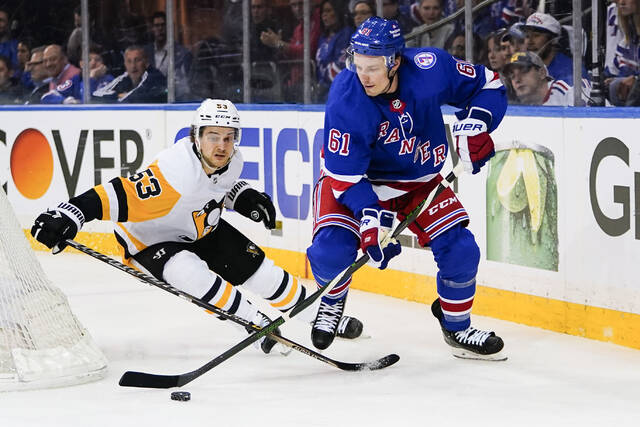Five stats-based observations about the Pittsburgh Penguins after a series-evening 4-2 loss to the New York Rangers in Thursday’s Game 2 at Madison Square Garden (analytics courtesy naturalstattrick.com unless specified otherwise):
1. Everything but the goals
The Penguins had more shots on goal Thursday, they had more attempted shots, they had more scoring chances, and they had more so-called “high-danger” scoring chances.
What they didn’t have, of course, was more goals.
In Game 2 at 5-on-5, the Penguins led in shots on goal 34-26, attempted shots 56-49, scoring chances 30-23 and — tellingly — high-danger scoring chances, 18-5. (The formula defining “scoring chances” and “high-danger scoring chances” uses the spot on the ice an attempted shot is taken, factoring in if it was rebound or in the transition game).
Through two games in each of the eight of the NHL first-round series, the Penguins lead all 16 playoff teams in percentage of scoring chances, high-danger chances and “expected goals for,” relative to their opponent, and the Penguins are also in the top five of shots on goal and attempted shots relative to the opponent.
2. Déjà vu, NY?
The series that so far for Penguins fans has been chillingly reminiscent of last year’s, when the first-round opponent also was a New York-based team, the Penguins also carried the play, and the Penguins had less to show for it than they probably deserved.
Hard to believe but among all 16 teams in last year’s playoffs — yes, even the Stanley Cup champion Tampa Bay Lightning and runner-up Montreal Canadiens — the Penguins had the postseason’s best percentage of shots attempted, best percentage of shots on goal and best percentage of scoring chances.
But they lost in the first round in six games.
3. Igor/Frankenstein
How can that happen, that a team that carries even-strength play can lose? One obvious way is goaltending. And losing the goalie matchup (through two games this season, anyway) has hurt the Penguins in each of the past two postseasons.
Last year, it was more the failings of Penguins goalie Tristan Jarry (.888 overall save percentage, league-worst .890 even-strength save percentage). This season, even while playing their Nos. 2-3 goalies, it hasn’t so much been that Casey DeSmith or Louis Domingue has been so bad as it has that they have been outplayed by presumptive Vezina Trophy winner Igor Shesterkin.
Shesterkin has a 5-on-5 save percentage of .952. The Penguins have converted just five of their 92 scoring chances in the series.
This is a continuation of the regular season for the Rangers, who had the worst attempted-shots percentage and high-danger scoring chances against of any team that would make the playoffs – but Shesterkin again and again saved the day.
4. No leads
With Game 1 extending well into a third overtime, this series so far has had 165 minutes and 58 seconds of on-ice action.
The Rangers have led for 62 minutes and 54 seconds of that time.
The score has been tied for 103 minutes, 4 seconds of that time.
The Penguins? They have held a lead for 0 minutes and 0 seconds
5. Penalty-killed
Through 78 games this season, the Penguins had a sparkling 86.4% penalty-kill percentage that was one of the best in franchise history.
By the time the Rangers’ Ryan Strome scored three minutes into Thursday’s second period, though, the Penguins’ PK was a good two weeks into hemorrhaging goals.
That tally meant opponents had scored a power-play tally in six consecutive games (dating back to the regular season). The Penguins hadn’t even allowed a streak of more than three games all season over the first 78 contests.
Strome’s goal meant the Penguins’ penalty kill had allowed eight goals in its past 16 opponent power-play opportunities (50%). For perspective, consider that the Penguins began the season by allowing eight power-play goals over their first 87 opponent chances covering 35 ½ games.








